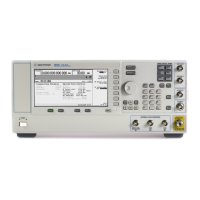Chapter 8 205
GPS Modulation (Option 409)
Real Time MSGPS
9. Type exit to end the command prompt session.
Downloading Scenario Files Using SCPI Commands (GPIB)
The following procedure describes how to download scenario files to a PSG using a SCPI command on a PC
connected to your PSG through a GPIB interface:
1. Open your web browser and type in the IP address of your PSG. The PSG’s Welcome webpage is
displayed.
2. Click
Signal Generator Web Control. Below the graphical representation of the PSG front panel is a field for
entering SCPI commands.
3. Enter the following command in the SCPI command field:
:MEMory:DATA "<GPS:file_name>",<data_block>
where file_name is the name of the destination file in PSG memory and GPS: specifies the destination
directory. Refer to the Programming Guide for a description of the <data_block> parameter.
NOTE Refer to the Programming Guide for more information on downloading files.
RF Power Level Considerations
When you set up your GPS test signal, pay special attention to the RF power level delivered to the GPS
receiver. Because typical GPS sensitivities are between −155 dBm and −159 dBm, delivering a GPS signal
to your device with a power level greater than −150 dBm or less than −160 dBm may produce invalid test
results.
If you use a physical connection to apply the GPS signal to your antenna, keep in mind that most GPS
antennas are active (a DC voltage is delivered to the antenna from the receiver). A DC block is therefore
required between the signal generator and the antenna. For direct connection, Agilent recommends setting
the signal generator RF output power to between −70 and −80 dBm and using an 80 dB attenuator and a DC
blocking device between the signal generator output and the antenna input of the receiver under test.
If you use a radiated connection, place your receiver in a calibrated test fixture designed with a link budget
that will deliver a −150 dBm to −160 dBm power level at the receiver antenna.
Using NMEA data to monitor signal power
One method to monitor the receiver’s perceived signal level is to monitor the National Marine Electronics
Association (NMEA) data stream from the receiver. Most GPS receivers have the capability to output data
via a serial RS232 connection in NMEA format. An NMEA message called GPGSV reports the signal
strength of the satellites that the GPS receiver is tracking. The GPGSV message reports a carrier-to-noise
(CNO) value for each observed satellite. As you monitor this message, increase or decrease the power to the
receiver until the receiver’s perceived CNO values are between 35 and 40. Table 8-1 on page 207 shows

